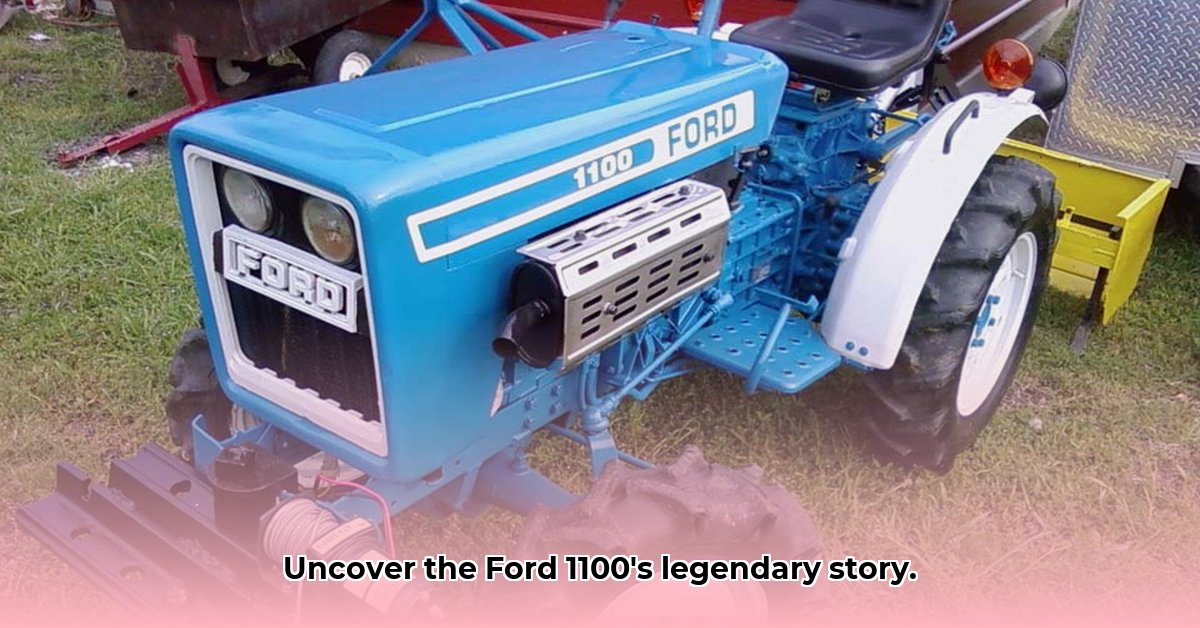
A Compact Powerhouse: The Ford 1100's Legacy
The Ford 1100 tractor, a compact marvel produced between 1979 and 1983, represents a fascinating intersection of agricultural technology and global collaboration. Born from a partnership between Ford and Shibaura, a Japanese manufacturer, the Ford 1100 answered a critical need for smaller farms seeking affordable, dependable machinery. This article delves into its history, technical specifications, maintenance, and lasting relevance, covering aspects crucial for both users and collectors. Did you know that the Ford 1100's success highlights the increasing globalization of agricultural equipment production? For more on Ford tractors, check out Ford tractor specs.
Historical Context: A Changing Agricultural Landscape
The late 1970s and early 1980s witnessed a shift in agricultural practices. While large-scale farms were on the rise, smaller operations still required efficient, cost-effective equipment. The Ford 1100, with its compact design and reliable performance, filled this niche perfectly. Its affordability and ease of use made it a popular choice for those whose needs were best served by a smaller, more versatile tractor. The Ford-Shibaura collaboration marked a pivotal moment, demonstrating an early example of the international partnerships that have since become commonplace in the agricultural machinery industry. How many other tractors from this era successfully bridged the gap between affordability and reliability?
Technical Specifications: Decoding the Ford 1100
The Ford 1100’s power comes from a Shibaura LEK752C2 engine. While documentation sometimes reports slightly varying horsepower figures (around 12-13 HP), this variance is common in older equipment and often results from differing testing methodologies. The consistently cited power output range of 9-10 kilowatts provides a reliable estimate. A key advantage of the 1100 lies in its transmission—ten forward and two reverse gears offer adaptability for a wide variety of tasks. Power transmission to implements is via a Category I three-point hitch, facilitating the use of various attachments. How did this relatively simple powertrain contribute to the Ford 1100's lasting reputation for reliability?
Here's a summarized overview of its key specifications:
| Specification | Value | Notes |
|---|---|---|
| Engine | Shibaura LEK752C2 | A robust and durable engine ideal for various applications. |
| Engine Power | Approximately 9-10 kW (~12-13 hp) | Reported horsepower may vary due to different testing methods. |
| Transmission | 10 Forward, 2 Reverse | Offers excellent gear selection for diverse tasks. |
| PTO Power | Approximately 8 kW (~11 hp) | Power take-off (PTO) for operating powered implements. |
| Hydraulic System | Open-center | A common and reliable hydraulic system design for this era. |
| Three-Point Hitch | Category I | Supports a wide range of implements and attachments. |
| Approximate Weight | ~1,100 lbs | Weight may vary based on configuration and optional accessories. |
Available Attachments: Expanding the Ford 1100's Utility
The true strength of the Ford 1100 lies in its adaptability. It wasn't just a tractor; it was a versatile platform. Numerous attachments expanded its capabilities beyond basic plowing. Mower decks transformed it into an efficient lawnmower, snow blowers tackled winter challenges, and front-end loaders facilitated material handling. The availability of various attachments significantly broadened the Ford 1100's utility. What are some of the most sought-after attachments for restoring a classic Ford 1100 today?
Operational Considerations: Maintenance and Safety
Maintaining a Ford 1100 involves regular checks of oil, hydraulic fluid, and other essential fluids. Detecting and addressing leaks or unusual noises early is crucial. While parts availability can be more challenging than with modern tractors, many online communities and specialized parts suppliers offer assistance. Safety should always be paramount. Always follow the accompanying operator's manual and utilize appropriate safety equipment. Can the timely replacement of specific parts significantly extend the lifespan of a Ford 1100?
Modern Relevance: A Continuing Legacy
Despite its age, the Ford 1100 retains relevance. Its compact size and versatility make it well-suited for small farms, hobby farming, and even landscaping projects. However, important limitations compared to modern tractors, such as less fuel efficiency and fewer advanced features, should be acknowledged. For various applications where a smaller, more maneuverable tractor is essential, the Ford 1100 remains a viable option. How does the Ford 1100 compare in terms of fuel efficiency to modern compact tractors?
Collecting and Restoration: A Rewarding Pursuit
The Ford 1100 has cultivated a dedicated following among collectors and enthusiasts. Restoring one is a rewarding endeavor, though it does require patience and resourcefulness in sourcing parts. Online forums and specialized suppliers can be invaluable resources. A restored Ford 1100 stands as a testament to dedication and represents a fascinating piece of agricultural history—a connection to a simpler era of farming. What are some of the most common challenges faced during the restoration of a vintage Ford 1100?
Risk Assessment Matrix: Prioritizing Safety
Safe operation necessitates a clear understanding of potential hazards and appropriate mitigation strategies. The following matrix highlights key risk areas:
| Risk Category | Specific Risk | Likelihood | Impact | Mitigation Strategies |
|---|---|---|---|---|
| Mechanical Failure | Engine, hydraulic, or transmission failure | Medium | High | Regular maintenance, preventative repairs, proactive parts sourcing. |
| Safety Hazards | Rollover (mitigated by ROPS, if equipped) | Medium | High | Operator training, careful operation, and the use of appropriate safety equipment. |
| Parts Availability | Difficulty finding replacement parts | High | Medium | Dedicated suppliers, online communities, salvage yards, and creative problem-solving. |
| Environmental Impact | Fuel/oil leaks | Low | Medium | Responsible fluid handling, regular maintenance, and prompt attention to any leaks. |
Conclusion: The Enduring Appeal of the Ford 1100
The Ford 1100 remains a compelling example of a compact tractor that successfully balanced affordability and dependability. Its continued relevance in smaller-scale agriculture, hobby farming, and the collector market underscores its enduring legacy. Understanding its mechanics, maintenance requirements, and potential risks is key to appreciating – and safely operating – this historical gem. What factors contributed most significantly to the Ford 1100's enduring popularity among collectors?